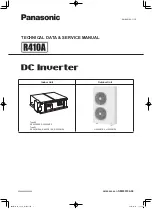
9
Decoder settings
5. Appendix
5.1. Programming Long Addresses
As described in chapter 3.3.1.2. the long address is split into two
CVs. The byte with the higher value of the address is in CV 17. This
byte determines the range in which the extended address will be
located. For instance, if you enter the value 192 in CV 17 then the
extended address may be between 0 and 255. If 193 is written into
CV 17 then the extended address will be between 256 and 511.
You can continue this up to addresses with values of 9984 and
10239. The possible values are shown in the table on the right.
5.1.1. Write address
To programme a long address you first of all need to calculate the
values for CV 17 and CV 18 and then programme it. Please note
that it is not possible to programme addresses via the program-
ming mode “POM”.
To programme the long address proceed as follows:
• First you determine the desired address, for instance 4007.
• Then you look for the appropriate address range in the table on
the right. The value to be entered into CV 17 can be found in the
column on the right. In our example, it is 207.
The value for CV 18 is established as follows:
esired address
4007
minus
first address in the address range -
3840
===============================
====
equals
value for CV 18
167
• 167 is therefore the value to be entered in CV 18. Thus your de-
coder is now programmed to address 4007.
5.1.2. Read out addess
If you wish to read out the address of a locomotive please read
the values of CV 17 and CV 18 one after another and proceed
then in reverse order:
Let’s assume you have read:
CV 17 = 196; CV 18 = 147. Look up the corresponding address
range in the table below. The first possible address within this
range is 1024. Then you have to add the value from CV 18 and
you arrive at the locomotive address:
1024
+
147
====
=
1171
Address Range
Address Range
Address Range
from
to
CV17
from
to
CV17
from
to
CV17
0
255
192
3584 3839 206
7168 7423 220
256
511
193
3840 4095 207
7424 7679 221
512
767
194
4096 4351
208
7680 7935
222
768
1023
195
4352 4607 209
7936 8191 223
1024
1279
196
4608 4863 210
8192 8447 224
1280
1535
197
4864 5119 211
8448 8703 225
1536
1791
198
5120 5375 212
8704 8959 226
1792
2047
199
5376 5631 213
8960 9215 227
2048
2303
200
5632 5887 214
9216 9471
228
2304
2559
201
5888 6143 215
9472 9727 229
2560
2815
202
6144 6399 216
9728 9983 230
2816
3071
203
6400 6655 217
9984 10239 231
3072
3327
204
6656 6911 218
3328
3583
205
6912 7167 219
Appendix


































